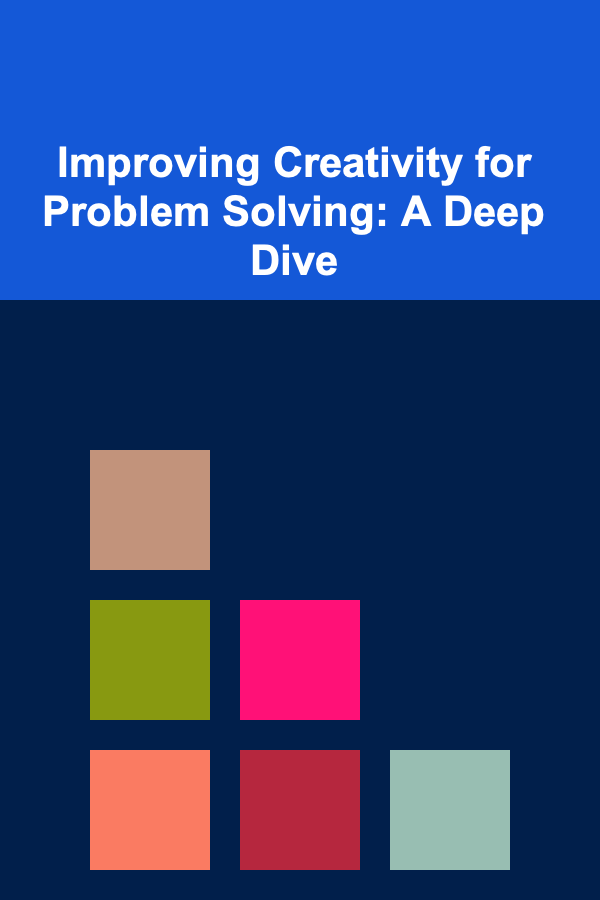
Improving Creativity for Problem Solving: A Deep Dive
ebook include PDF & Audio bundle (Micro Guide)
$12.99$6.99
Limited Time Offer! Order within the next:

In today's rapidly evolving world, the ability to creatively solve problems is no longer a desirable skill; it's an absolute necessity. From navigating complex business challenges to addressing global issues like climate change and healthcare disparities, innovative solutions are the cornerstone of progress. However, creativity isn't a magical gift bestowed upon a select few. It's a muscle that can be strengthened and honed through conscious effort and strategic practices. This article delves into the multifaceted nature of creativity in problem-solving and provides actionable strategies to unlock and enhance your creative potential.
Understanding Creativity in Problem Solving
Before we explore specific techniques, it's crucial to define what we mean by "creativity" in the context of problem-solving. It's not simply about artistic expression or generating outlandish ideas. Instead, it encompasses the ability to:
- Generate Novel Ideas: Going beyond the obvious and exploring uncharted territories of thought. This involves breaking free from conventional thinking patterns and daring to consider unconventional possibilities.
- Make Connections: Identifying relationships between seemingly disparate concepts and leveraging those connections to create something new. This requires a broad knowledge base and the ability to synthesize information from diverse sources.
- Challenge Assumptions: Questioning established norms and beliefs to uncover hidden biases and explore alternative perspectives. This is essential for identifying the root causes of problems and developing truly innovative solutions.
- Evaluate and Refine: Critically assessing generated ideas, identifying their strengths and weaknesses, and iteratively refining them to create viable and effective solutions. Creativity isn't just about ideation; it's also about execution and improvement.
- Embrace Ambiguity: Comfortably navigating uncertainty and complexity, recognizing that the problem-solving process is often iterative and non-linear. This requires a willingness to experiment, learn from failures, and adapt to changing circumstances.
Creativity, therefore, is a dynamic interplay of divergent thinking (generating multiple ideas) and convergent thinking (evaluating and selecting the best ones). It's a process that requires both imagination and critical analysis.
Barriers to Creative Problem Solving
Identifying the obstacles that hinder creative thinking is the first step towards overcoming them. Several factors can stifle creativity, including:
- Functional Fixedness: The tendency to perceive objects only in terms of their typical use, limiting the ability to see alternative applications. For example, viewing a brick only as a building material, rather than a potential paperweight or a tool for marking a boundary.
- Confirmation Bias: The tendency to seek out information that confirms existing beliefs and ignore information that contradicts them. This can lead to a narrow and biased perspective, hindering the exploration of alternative solutions.
- Mental Fixation: Becoming stuck in a particular line of thinking, making it difficult to consider alternative approaches. This can be caused by past successes or ingrained habits.
- Fear of Failure: The anxiety associated with making mistakes, which can inhibit experimentation and risk-taking. A culture that punishes failure can stifle creativity and innovation.
- Lack of Time and Resources: Insufficient time for brainstorming, research, and experimentation can limit the ability to explore creative solutions. Adequate resources, including funding and equipment, are also essential.
- Groupthink: The pressure to conform to the opinions of the group, which can stifle dissenting voices and limit the diversity of ideas. A lack of psychological safety within the group can exacerbate this problem.
Recognizing these barriers is crucial for developing strategies to mitigate their impact and create an environment that fosters creativity.
Techniques for Enhancing Creativity
Fortunately, numerous techniques can be employed to boost creative problem-solving skills. These techniques aim to stimulate new ideas, break mental fixations, and foster a more open and flexible mindset.
1. Brainstorming and its Variations
Brainstorming, the classic method for generating ideas, involves gathering a group of people and encouraging them to freely share any ideas that come to mind, without criticism or judgment. However, traditional brainstorming can sometimes be dominated by a few vocal individuals, hindering the contributions of others. Several variations can address these limitations:
- Brainwriting: Each participant writes down their ideas on a piece of paper, then passes it to the next person, who adds their own ideas based on what they see. This process continues until everyone has contributed to each paper, resulting in a diverse collection of ideas. Brainwriting helps to overcome the influence of dominant personalities and encourages more introverted individuals to participate.
- Reverse Brainstorming: Instead of focusing on solutions, participants brainstorm potential problems or obstacles related to the topic. This can help to identify hidden assumptions and uncover new perspectives on the challenge.
- Nominal Group Technique (NGT): A structured brainstorming approach that involves individual idea generation, followed by a round-robin sharing of ideas, a discussion to clarify and evaluate each idea, and a silent voting process to rank the ideas. NGT promotes equal participation and reduces the risk of groupthink.
Regardless of the specific method used, effective brainstorming requires clear objectives, a supportive environment, and a facilitator to guide the process and ensure that all participants have an opportunity to contribute.
2. Lateral Thinking
Coined by Edward de Bono, lateral thinking is a problem-solving technique that involves approaching problems from unconventional angles and challenging assumptions. It contrasts with vertical thinking, which relies on logical progression and incremental improvements.
- Random Word Technique: Choose a random word unrelated to the problem and try to connect it to the problem. This can trigger new associations and break mental fixations. For example, if you're trying to improve customer service, and the random word is "umbrella," you might think about providing customers with protection from unexpected issues or shielding them from frustrating experiences.
- Provocation: Intentionally introduce a provocative statement or idea that challenges existing assumptions. For example, instead of asking "How can we improve our product?", ask "What if we deliberately made our product worse?". This can force you to think about the product in a new light and identify hidden strengths or weaknesses.
- Alternatives: Actively seek out alternative explanations, perspectives, and solutions, even if the initial answer seems obvious. Continuously ask "What else could it be?" or "What else could we do?".
Lateral thinking encourages a more playful and exploratory approach to problem-solving, allowing for the discovery of innovative and unexpected solutions.
3. SCAMPER
SCAMPER is a checklist of prompts that can be used to generate new ideas by modifying existing products, services, or processes. Each letter in SCAMPER represents a different type of modification:
- Substitute: What can be substituted? Which elements can be replaced with something else?
- Combine: What can be combined? Can different elements be integrated?
- Adapt: What can be adapted? How can the product or process be modified to fit a new purpose?
- Modify/Magnify/Minimize: What can be modified? What can be magnified or minimized? Can any elements be exaggerated or reduced?
- Put to other uses: What else can it be used for? Can it be used in a different industry or for a different purpose?
- Eliminate: What can be eliminated? Which elements can be removed without affecting the core functionality?
- Reverse/Rearrange: What can be reversed or rearranged? Can the order of steps be changed? Can the product be flipped or turned inside out?
By systematically applying each prompt to a problem or product, you can generate a wide range of potential improvements and innovations. SCAMPER is particularly useful for incremental innovation and improving existing solutions.
4. Mind Mapping
Mind mapping is a visual brainstorming technique that involves creating a diagram to represent ideas and their relationships. Start with a central idea or problem, and then branch out with related concepts, subtopics, and keywords. Use colors, images, and symbols to enhance the visual appeal and stimulate ассоциации.
Mind mapping helps to organize thoughts, identify connections between ideas, and generate new insights. It's a particularly effective technique for visual learners and for complex problems with multiple interconnected factors.
5. Analogy and Metaphor
Using analogies and metaphors can help to reframe a problem and see it from a new perspective. An analogy draws a comparison between two different things that share some common characteristics, while a metaphor uses one thing to represent another.
For example, if you're struggling with a team conflict, you might use the analogy of a tangled fishing line. This analogy can help you to identify the different strands of the conflict and develop strategies for untangling them. Or, if you're trying to design a user-friendly interface, you might use the metaphor of a garden, where users can easily navigate and explore different areas.
Using analogies and metaphors can unlock new insights and inspire creative solutions by drawing parallels between seemingly unrelated domains.
6. Design Thinking
Design thinking is a human-centered problem-solving approach that emphasizes empathy, experimentation, and iteration. It typically involves five stages:
- Empathize: Understand the needs, motivations, and pain points of the users or stakeholders affected by the problem. This involves conducting interviews, observations, and other research methods to gain a deep understanding of their perspective.
- Define: Clearly define the problem based on the insights gained during the empathize stage. Frame the problem in a way that is human-centered and actionable.
- Ideate: Generate a wide range of potential solutions to the problem, using brainstorming and other ideation techniques. Encourage wild ideas and avoid premature judgment.
- Prototype: Create rough prototypes of the most promising solutions, focusing on functionality and user experience. Prototypes can be simple sketches, paper models, or digital mockups.
- Test: Test the prototypes with users or stakeholders, gather feedback, and iterate on the design based on the results. The testing phase is crucial for identifying flaws and refining the solution.
Design thinking is a powerful approach for solving complex problems that require a deep understanding of human needs and a willingness to experiment and iterate.
7. Challenging Assumptions
Often, the biggest barrier to creative problem-solving is the set of assumptions we hold about the problem and its potential solutions. Actively challenging these assumptions can open up new possibilities and unlock innovative solutions.
- Identify Assumptions: Write down all the assumptions you're making about the problem, the stakeholders involved, and the potential solutions.
- Challenge Each Assumption: For each assumption, ask "What if this wasn't true?". Explore the consequences of each assumption being false.
- Reframe the Problem: Based on the challenged assumptions, reframe the problem in a new light. This can lead to new insights and potential solutions.
For example, if you're trying to improve employee productivity, you might assume that employees are lazy or unmotivated. Challenging this assumption might lead you to consider other factors, such as lack of resources, poor training, or a toxic work environment.
Cultivating a Creative Environment
While techniques are important, fostering a conducive environment is equally crucial for nurturing creativity. This involves creating a culture that encourages experimentation, risk-taking, and open communication.
- Encourage Risk-Taking: Create a safe space where individuals feel comfortable taking risks and making mistakes. Reward experimentation and learning from failures.
- Promote Collaboration: Foster cross-functional collaboration and create opportunities for individuals from different backgrounds and perspectives to interact.
- Embrace Diversity: Encourage diversity of thought and experience within the team. Different perspectives can lead to new insights and more creative solutions.
- Provide Time and Resources: Allocate sufficient time and resources for brainstorming, research, and experimentation. Protect individuals from distractions and interruptions.
- Encourage Curiosity and Learning: Promote a culture of continuous learning and encourage individuals to explore new ideas and perspectives.
- Celebrate Successes: Recognize and celebrate creative achievements, both big and small. This reinforces the value of creativity and encourages further innovation.
Developing Personal Habits for Creative Problem Solving
Beyond organizational practices, individual habits play a significant role in cultivating creativity.
- Practice Mindfulness: Mindfulness meditation can help to reduce stress, improve focus, and enhance creativity. Regular mindfulness practice can also help to cultivate a more open and accepting mindset.
- Engage in Creative Hobbies: Participating in activities like painting, writing, music, or dance can stimulate creativity and provide new perspectives. These hobbies can also help to reduce stress and improve overall well-being.
- Read Widely: Expand your knowledge base by reading books, articles, and blogs on a variety of topics. Exposure to new ideas and perspectives can spark new insights and connections.
- Travel and Explore: Traveling to new places and experiencing different cultures can broaden your horizons and stimulate creativity. Even exploring your own city in a new way can spark new ideas.
- Keep a Journal: Record your thoughts, ideas, and observations in a journal. This can help you to track your progress, identify patterns, and generate new insights.
- Surround Yourself with Inspiration: Create a workspace that is inspiring and stimulating. Surround yourself with objects, images, and quotes that inspire you.
- Take Breaks: Stepping away from a problem for a short period of time can help you to clear your head and approach it with a fresh perspective. Take a walk, listen to music, or do something else that you enjoy.
- Embrace Failure as a Learning Opportunity: View failures not as setbacks, but as opportunities to learn and grow. Analyze what went wrong and use that knowledge to improve your future problem-solving efforts.
Conclusion
Improving creativity for problem-solving is a continuous journey that requires conscious effort, strategic practices, and a supportive environment. By understanding the nature of creativity, identifying the barriers that hinder it, and employing the techniques outlined in this article, you can unlock your creative potential and become a more effective problem solver. Remember that creativity is a muscle that strengthens with practice, so embrace experimentation, challenge assumptions, and cultivate a mindset of continuous learning. The world needs creative solutions to address its most pressing challenges, and by investing in your own creative development, you can contribute to a more innovative and sustainable future.

How to Create a Stunning Holiday Entryway That Welcomes Guests
Read More
How to Defrost Your Freezer Properly
Read More
How to Maintain Your Home's Water Filtration System
Read More
How to Sell Vintage Home Goods on Instagram: An Actionable Guide
Read More
How To Use Figma for UI/UX Design
Read More
How To Practice Deep Work for Maximum Productivity
Read MoreOther Products

How to Create a Stunning Holiday Entryway That Welcomes Guests
Read More
How to Defrost Your Freezer Properly
Read More
How to Maintain Your Home's Water Filtration System
Read More
How to Sell Vintage Home Goods on Instagram: An Actionable Guide
Read More
How To Use Figma for UI/UX Design
Read More